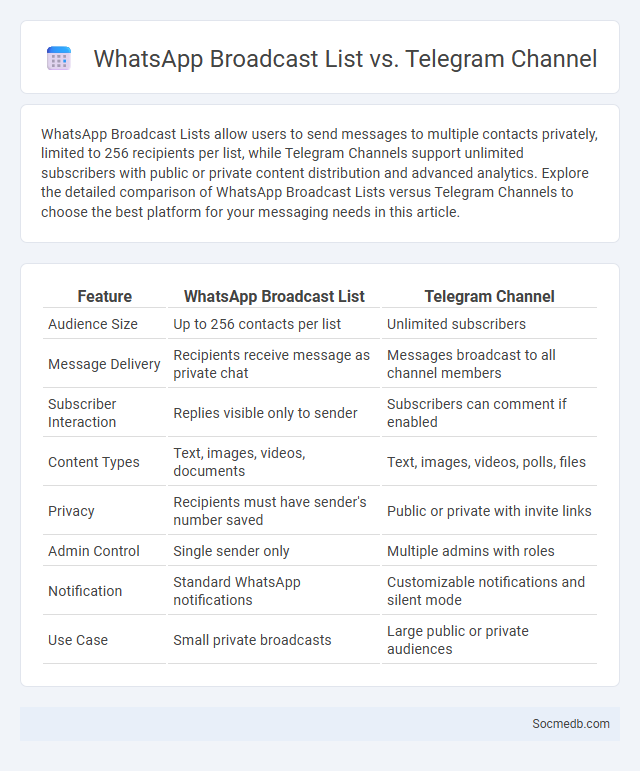
Photo illustration: WhatsApp Broadcast List vs Telegram Channel
WhatsApp Broadcast Lists allow users to send messages to multiple contacts privately, limited to 256 recipients per list, while Telegram Channels support unlimited subscribers with public or private content distribution and advanced analytics. Explore the detailed comparison of WhatsApp Broadcast Lists versus Telegram Channels to choose the best platform for your messaging needs in this article.
Table of Comparison
| Feature | WhatsApp Broadcast List | Telegram Channel |
|---|---|---|
| Audience Size | Up to 256 contacts per list | Unlimited subscribers |
| Message Delivery | Recipients receive message as private chat | Messages broadcast to all channel members |
| Subscriber Interaction | Replies visible only to sender | Subscribers can comment if enabled |
| Content Types | Text, images, videos, documents | Text, images, videos, polls, files |
| Privacy | Recipients must have sender's number saved | Public or private with invite links |
| Admin Control | Single sender only | Multiple admins with roles |
| Notification | Standard WhatsApp notifications | Customizable notifications and silent mode |
| Use Case | Small private broadcasts | Large public or private audiences |
Introduction to Broadcast Messaging Apps
Broadcast messaging apps enable you to send one-to-many communications efficiently, reaching large audiences instantly through platforms like WhatsApp, Telegram, and Facebook Messenger. These apps support multimedia content, real-time updates, and tailored notifications, enhancing engagement and brand visibility. Leveraging broadcast messaging tools can optimize your marketing strategy by delivering targeted messages directly to subscriber lists without individual interactions.
What is a WhatsApp Broadcast List?
A WhatsApp Broadcast List allows users to send messages to multiple contacts simultaneously without creating a group chat, maintaining recipients' privacy. Each message appears as an individual chat to the recipients, enabling personalized communication at scale. This feature is ideal for businesses and individuals seeking efficient, direct outreach to clients or friends without overlapping conversations.
How Does a Telegram Channel Work?
A Telegram channel operates by allowing administrators to broadcast messages to an unlimited number of subscribers, who receive updates instantly without the ability to reply publicly, ensuring one-way communication. Channels can share various content types, including text, images, videos, and files, with messages stored securely on Telegram's cloud servers for easy access across devices. The platform's robust encryption and privacy settings enable channel owners to control membership, manage content visibility, and track engagement through view counts and analytics.
Broadcast Lists on Telegram: An Overview
Broadcast Lists on Telegram enable you to send messages to multiple contacts simultaneously without creating a group, preserving privacy and preventing responses from recipients from cluttering your chat interface. This feature is ideal for businesses, influencers, or users aiming to share announcements, promotions, or updates efficiently with a targeted audience. By leveraging Telegram's Broadcast Lists, you can enhance communication reach while maintaining a personalized touch to your messages.
Key Differences: WhatsApp Broadcast vs Telegram Channel
WhatsApp Broadcast allows you to send messages to contacts who have saved your number, ensuring personal reach but limiting audience size, while Telegram Channel enables unlimited subscribers with public or private access, ideal for large-scale broadcasting. Telegram Channels offer advanced features like post editing, statistics, and multimedia support, giving you greater control over content engagement and analytics. Your choice depends on whether you need direct contact with known recipients or broader, scalable distribution.
Privacy and Security Comparison
Social media platforms vary significantly in privacy and security features, with end-to-end encryption provided by apps like Signal and WhatsApp offering stronger data protection than platforms such as Facebook or Instagram, which collect extensive user information for targeted advertising. Features like two-factor authentication (2FA) and regular security audits enhance account safety, while platform transparency reports and data breach histories serve as key indicators of overall trustworthiness. Users should evaluate privacy policies, data retention practices, and default security settings to select platforms that best safeguard their personal information against unauthorized access.
Message Reach and Limitations
Social media platforms enable message reach by leveraging algorithms that target specific demographics, increasing content visibility to millions of active users worldwide. However, limitations such as algorithmic biases, content saturation, and platform-specific restrictions often hinder organic reach and engagement rates. Understanding these factors is crucial for optimizing social media campaigns and maximizing audience impact.
User Engagement and Interaction Features
Social media platforms enhance user engagement through interactive features such as likes, comments, shares, and real-time messaging, fostering dynamic communication and community building. Algorithms tailored to personalize content feeds increase user retention by delivering relevant posts and advertisements based on behavior and preferences. Interactive tools like polls, live videos, and story reactions stimulate active participation, boosting platform activity and user satisfaction.
Use Cases: Business, Community, and Personal Use
Social media drives business growth by enabling targeted advertising, customer engagement, and brand awareness. It fosters community building through group interactions, event coordination, and support forums that connect individuals with shared interests. On a personal level, social media facilitates communication, self-expression, and networking with friends and family worldwide.
Choosing the Best Broadcast Tool for Your Needs
Selecting the best broadcast tool for your social media strategy involves analyzing platform compatibility, audience reach, and feature sets such as live streaming quality, real-time interaction, and analytics integration. Tools like Facebook Live, YouTube Live, and Twitch offer specialized capabilities suited for different content types and target demographics. Prioritize options that support multi-platform broadcasting and provide robust user engagement metrics to maximize content visibility and viewer retention.
 socmedb.com
socmedb.com